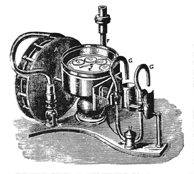Thomas Skinner, MD
August 11, 1825- October 11, 1906
Educated in medicine at Edinburgh University, Skinner was an outspoken critic of homeopathy. After becoming ill and having to give up his practice to preserve his health, he was treated by Dr. Edward Berridge who had trained in the USA at Hahnemann Medical College. Skinner was given an MM dose of Sulphur and had a complete recovery.
He dove into homeopathy whole-heartedly. He studied homeopathy under Berridge, and read Hahnemann's three major works— The Organon, The Materia Medica Pura, and The Chronic Diseases. When he felt secure in his homeopathic practice he announced his changed practice and resigned from the Liverpool Medical Institute— which prohibited the membership of homeopaths through a law put into place years earlier by Skinner himself.
Skinner attended the International Exposition in Philadelphia in 1876, and upon his return to England he founded (with Edward Berridge in the UK and Adolph Lippe and Samuel Swan in the USA) The Organon— "An Anglo-American Journal of Homoeopathic Medicine and Progressive Collateral Science." Although it ceased publication after the first issue of Volume 4 in 1881, it became the pacesetter for journals devoted to pure Hahnemannian homeopathy that followed— the Homoeopathic Physician and The Medical Advance.
Skinner practiced in Liverpool, England. He was, in the words of H. C. Allen, "probably the best prescriber in Britain."
He died two weeks after injuring himself in a fall when he slipped on a banana peel.
Skinner's Machine
The "Skinner Centesimal Fluxion Potentiser" was first described in an article by Thomas Skinner, MD in "The Organon (Vol. I, p. 45)."

Very early on, Skinner was unsure if it was the dilution or the succussion which was the deciding factor in preparing remedies. He conducted an experiment in which he took a two-dram vial, and placed in it one drop of Sulphur tincture. He then filled the vial slowly. He then emptied it and repeated the process a thousand times. When the next patient arrived that needed Sulphur, he gave a dose of the potency he had prepared. The patient had such a strong reaction that it had to be antidoted.
This was the starting point of developing a machine that would prepare remedies by a similar process.
The machine was designed to be used over a wash-basin in a doctor's office. The water supply from the faucet was attached to the machine and provided the motive power through the "water wheel." The machine held two potentizing vials. The vials had a spherical bottom and each held just 100 minims of liquid. The water supply was adjusted (with the stop-cocks) so that the vial was filled with 100 minims of water before overturning quickly and forcibly ejecting the contents into the sink and down the drain.
In theory, one drop was left adhering to the wall of the vial. The vial what then returned to the upright position and the process repeated.
Dr. Skinner wrote that because of all the ways of adjusting the water flow of the machine, that there was "no difficulty obtaining mathematical certainty" in the potencies.
The machine could make 50 potencies a minute, 8,000 an hour, 72,000 per day, and a 100,000 (CM) in about 33 hours. An MM (a 1,000,000) could be made in 330 hours or 14 days.
He said that his "Fluxion Centesimal" (F.C.) potencies are made "by a process such as Hahnemann himself, if he could witness them, would highly approve, because all the essential points are most scrupulously observed and greatly improved upon, whilst time has enormously economized, and error is next to an impossibility, so perfect are the methods used."
Skinner's original machine is on display at the Faculty of Homeopathy Library in London.
In about 1900, Boericke & Tafel installed a Skinner Machine in their pharmacy.

Very informative article, Dr Shah. Much to be understood in this area of preparation and potentisation of homeopathic medicines. keep sharing.
ReplyDeleteNice blog, Are you think about how to choose the Best Medical College? There are plenty numbers ofBest Medical College in Philippines, where they can provide the best education and high Score.
ReplyDelete